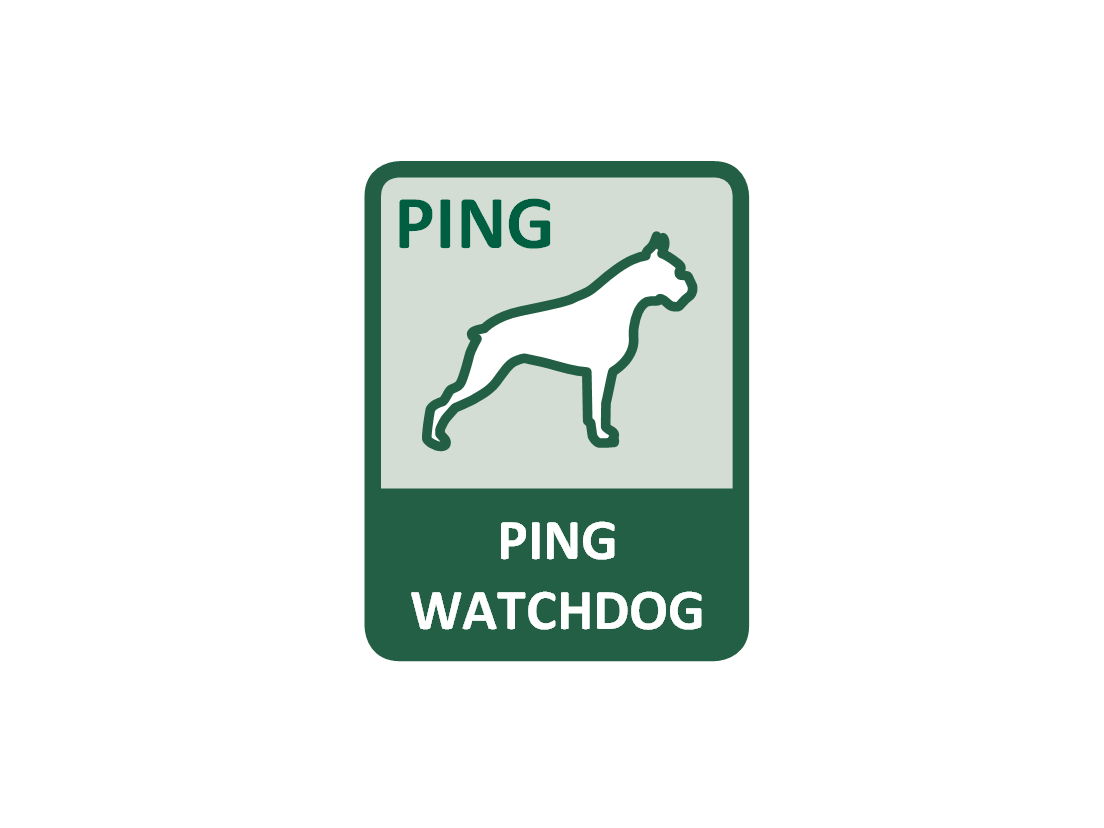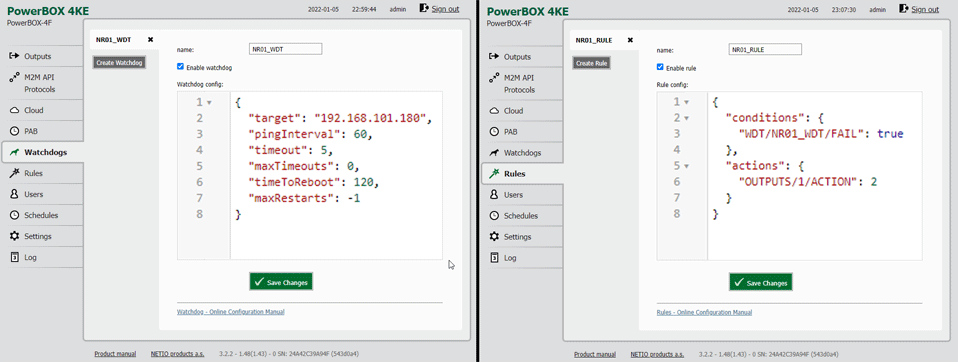
The “IP WatchDog” or "Ping WatchDog" term refers to a method of detecting if an IP device works correctly. IP device functionality is usually monitored using ICMP PING replies. A device is considered to be functioning if it is connected to the network and responds to PING requests. If a reply to a PING request fails to arrive (within a specified time or after a certain number of retries), the IP Watchdog device restarts the device (by disconnecting the power for a short time).
In general, the IP WatchDog function replaces a human who would have to travel several km (or hours) to the site just to flip the power switch off and on. With the "IP WatchDog", the device is power-cycled without human intervention. Often, end users don’t even notice that something was not working.
-
In the context of NETIO products, the ping based Watchdog detects the monitored device function as well as the network connection. This way, the basic functioning of the device is checked together with the network elements (microwave links, routers, switches) along the route.
-
This function is sometimes referred to as Autoping or Heartbeat / PING Heartbeat or even WatchDog only.
-
Each output of the NETIO device can be used to monitor different devices (IP addresses) independently.
- It's worth noting that PING reply does not guarantee the tested device proper functionality. For example, an IP surveillance camera with a lens or image encoding problem can still reliably respond to PING over the network even though it does not work as it should.
IP WatchDog in the context of NETIO products
NETIO products company is using several different technologies for WatchDog functionality in its products.
- WatchDog (PING) functionality based on "Condition" & "Action" (WatchDog & Rules) definition. Supported by all NETIO products except PowerPDU 4C, described in AN61.
-
Power consumption WatchDog functionality based on "Condition" & "Action" (PABs & Rules) definition. Supported by all NETIO products except PowerPDU 4C, described in AN62.
- IP WatchDog function - Web based single page interface, limited features, PowerPDU 4C only, no updates planned
- LUA scripts - LUA script editable in device WEB interface, contains many features but programming skills recommended, PowerPDU 4C only, described in AN09, no updates planned
NETIO Devices overview
-
WatchDog based on "Condition" & "Action" (WatchDog & Rules)
- PowerBOX 3Px - Ping WatchDog
- PowerBOX 4Kx - Ping + Power consumption based WatchDog
- PowerCable REST 101x - Ping + Power consumption based WatchDog
- PowerCable 2PZ - Ping WatchDog
- PowerCable 2KZ - Ping + Power consumption based WatchDog
- PowerDIN 4PZ - Ping + Power consumption based WatchDog
- PowerPDU 4PS - Ping based WatchDog
-
PowerPDU 8QS - Ping + Power consumption based WatchDog
-
WatchDog based on LUA + WatchDog function
-
NETIO PowerPDU 4C - Ping only (Watchdog function (web interface) + Lua scripts)
-
NETIO PowerPDU 4C - Ping only (Watchdog function (web interface) + Lua scripts)
PING WatchDog: "Condition" & "Action" (WatchDog & Rules)
NETIO devices use a system of "Condition" & "Action" which has to be configured separately (in 2 different tabs). To configure even simple IP WatchDog you have to configure 2 tabs:
- Watchdog (IP address to be monitored)
- Rules (what to do if defined state happens)
Detailed description and examples in the NETIO Wiki - "Local device scripting".

PING WatchDog (PowerPDU 4C): LUA + WatchDog function
Linux based NETIO PowerPDU 4C handles IP Watchdog in a different way than in other NETIO products.
PowerPDU 4C contains an integrated IP WatchDog function that can be used to check availability of another device in the network using the “ping” command (ICMP protocol). If the WatchDog function does not receive a response within a specified time, it power-cycles the socket (Short Off) to reboot the connected device.
- To detect the failure of a single device, it is sufficient to specify the IP address of this device.
- To monitor a connection to a network (e.g. to verify the functioning of a microwave link), we recommend to monitor PING responses from two different IP addresses. This will prevent WatchDog from restarting an otherwise perfectly working Internet connection over and over if one particular device is down.
IP WatchDog by NETIO PowerPDU 4C (built-in function + 3 Lua extensions)
1) IP WatchDog function in device settings (web administration).
Checks for a response from a single IP address. Can be configured for each output separately.
2) AN09: IP Watchdog 1 of 2 – PING based failure detection for 1 or 2 devices (Lua script)
The status is considered OK if a reply is received from at least one of two IP addresses. Can be used to monitor Internet connectivity given that backup address (e.g. Google server 8.8.8.8) should always be available.
AN09 demonstrates a Lua script that detects a dropped Internet connection and automatically restarts e.g. a microwave link. The script periodically sends PING (icmp) requests to 1 or 2 configured IP addresses. When none of these two addresses responds for e.g. 60 seconds, one of the 230V sockets is turned off for 20 seconds (short off – restart).
3) AN24: IP WatchDog 1 to 1 – device LAN connectivity detection and indication (Lua script)
Detects and indicates the network presence of a device. Suitable to e.g. monitor the status of a network printer in order to switch off certain equipment when the printer is powered off.
AN24 is a Lua script that detects the presence of an IP address in the network and signals the result by switching a selected output on or off. In this way, it is possible for example to switch off certain equipment when a central printer is switched off, or to signal that someone is present in an office (reachable IP address of a notebook or a phone).
4) AN25: IP WatchDog 2 from 10 – list of monitored devices, failure indication by power output (Lua script)
This is a simple function for IT departments; a failure can be signaled by turning on a red light. The light turns on when 1 or more IP addresses specified in a table (10 target addresses) fail to respond for a specified time period (or for a specified number of attempts).
Do you need an indication that any out of 10 LAN devices is not working or unavailable? Regardless of whether a cable got loose, WiFi was disconnected or the UPS failed, when one or more of the ten devices fail to respond to PING, the Lua script described in this Application Note lights up a red warning light.
Do you need to write different IP WatchDog conditions in Lua? Contact us for details.




